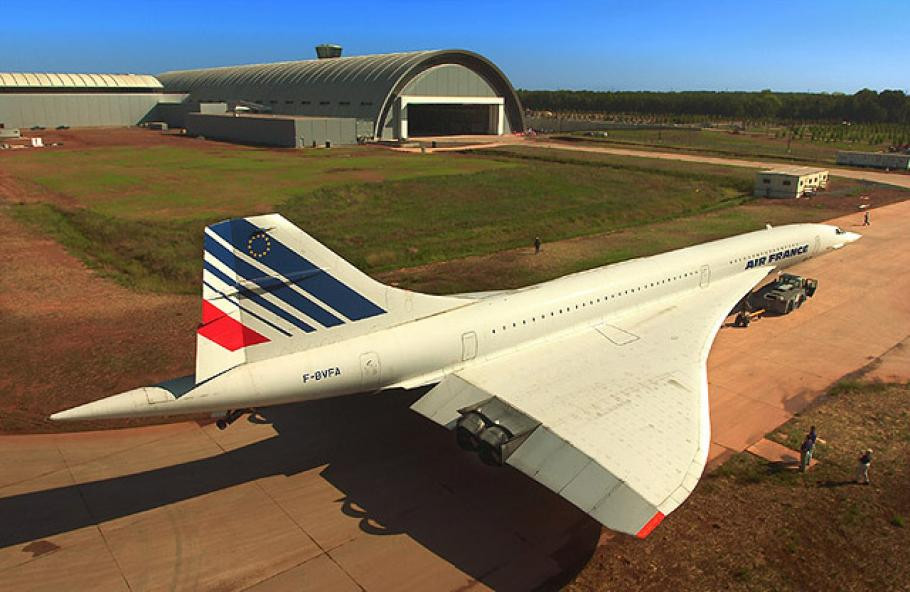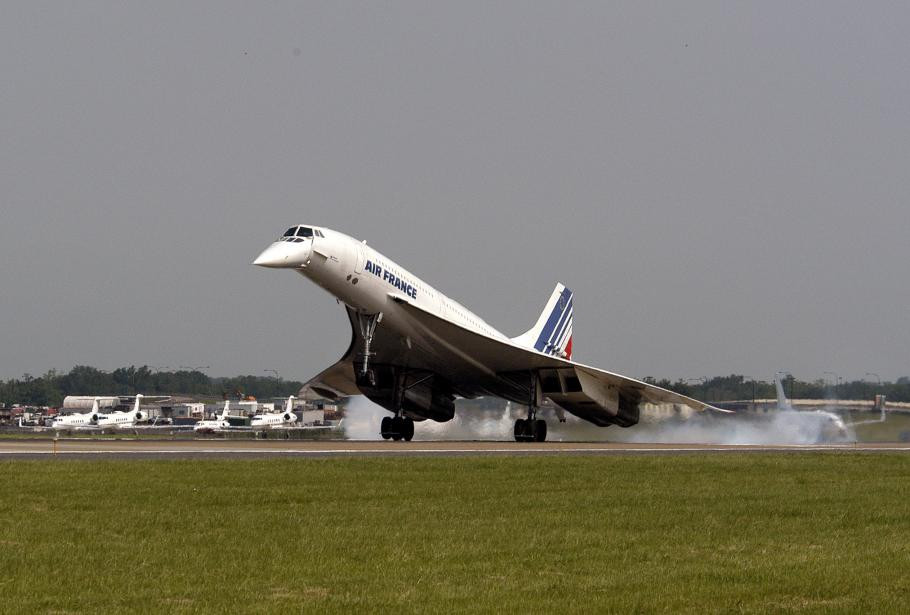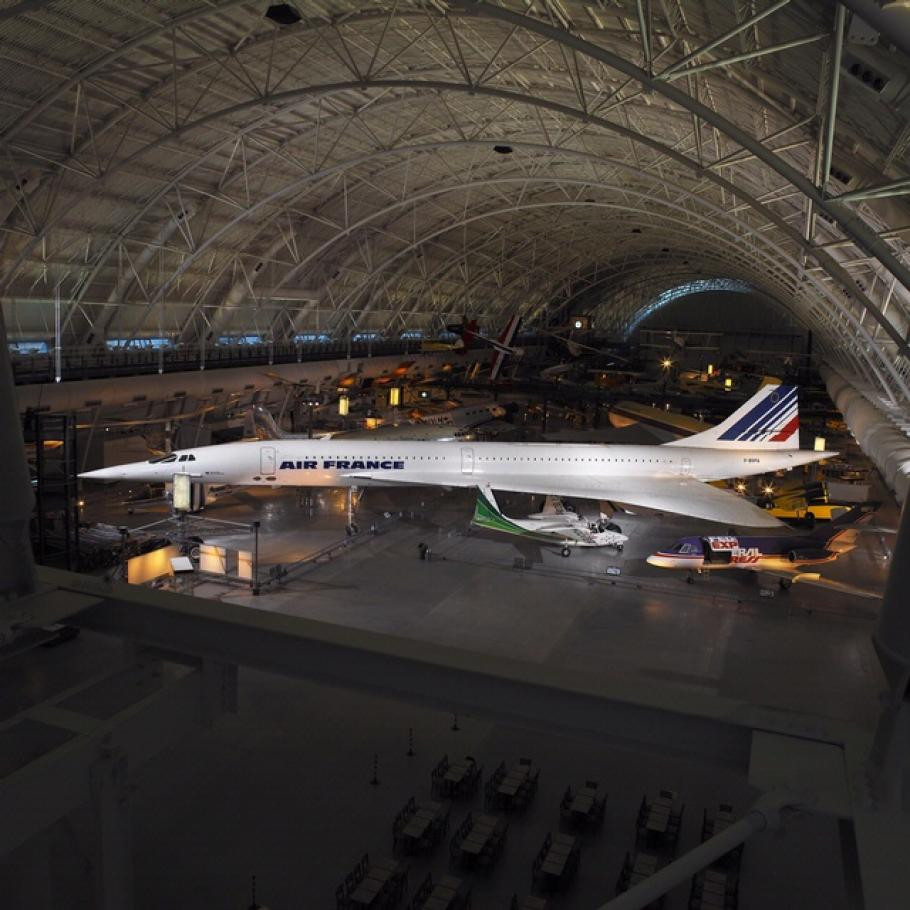Did you know that the Concorde, a symbol of aviation excellence, once whisked passengers across the Atlantic at twice the speed of sound? At flyermedia.net, we delve into the history of this remarkable aircraft, exploring its operational lifespan and the factors that led to its retirement. Uncover fascinating facts about aviation innovation, luxury travel, and the future of flight.
1. What Made the Concorde So Special?
The Concorde was not just an airplane; it was an aviation marvel, renowned for its aesthetics, innovative design, incredible speed, and luxurious passenger experience. For over half a century, it has remained an iconic symbol of flight, representing the pinnacle of aviation engineering. The Concorde was the first supersonic airliner powered by turbojet engines, transporting passengers across the Atlantic at more than twice the speed of sound.
What Exactly Is a Turbojet-Powered Supersonic Aircraft?
A turbojet engine is a type of jet engine that operates by taking in air, compressing it, mixing it with fuel, and igniting the mixture to produce thrust. This thrust propels the aircraft forward. The Rolls-Royce Olympus engines on the Concorde generated 38,000 pounds of thrust, enabling the aircraft to reach a maximum speed of 1,330 mph. Designed and built by Sud Aviation, later part of Aerospatiale (now Airbus) of France, and the British Aircraft Corporation, the Concorde was a stunning technological achievement. The name ‘Concorde’ signifies agreement or harmony in both English and French.
Flying at altitudes between 55,000 and 60,000 feet, nearly twice the altitude of commercial jets, the Concorde could achieve incredible speeds. Passengers could even witness the curvature of the Earth at maximum altitude. Accommodating 92 to 128 passengers, the Concorde provided luxury service tailored for elite travelers, featuring a four-across seating arrangement.
 Concorde at Udvar-Hazy Center
Concorde at Udvar-Hazy Center
The Museum’s Air France Concorde arrives at the Steven F. Udvar-Hazy Center, after landing at Washington Dulles International Airport, highlighting its historic journey and technological marvels.
The Concorde’s design featured a tailless body, a slim fuselage, and an ogival delta wing, which combined the high-speed efficiency and structural benefits of a delta wing with the smoothness of an ogival shape, enhancing performance and stability at high speeds. It also incorporated a droop nose that lowered to improve visibility during landing and take-off. Notably, the Concorde could sustain supersonic speed without using afterburners.
2. What Was the Historical Context Surrounding the Concorde’s Development?
The 1960s and ‘70s were a period of significant advancements in aviation and space travel. The introduction of jet airliner service transformed travel in the 1960s, and the Moon landing occurred in 1969. The Boeing 747 revolutionized air travel after entering service in 1970, followed by the Concorde in 1976. The aerospace industry was heavily focused on technological innovation and speed, driven by competition among nations and aerospace companies to reduce global travel times.
The Soviet Union pioneered the supersonic jet airliner age with the launch of the Tu-144 in 1968. The Tu-144 had a higher speed of Mach 2.15 compared to the Concorde’s Mach 2.04. However, it did not achieve sustainable success due to its inefficiency and high operational costs. The Tu-144 required afterburners throughout the flight and only operated on the Moscow to Almaty route. Shortly after, the French-Anglo Concorde, with a more sustainable design, was ready for test flights.
 Tu-144 in flight
Tu-144 in flight
A Tupolev Tu-144 supersonic passenger airliner showcases the Soviet Union’s attempt to enter the supersonic travel market, but it faced challenges in sustainability and efficiency.
Concordes aimed to significantly reduce travel times compared to subsonic airliners, targeting passengers willing to pay premium fares for faster travel between major cities like London and New York. During the Cold War, Britain and France collaborated to develop a commercial airliner capable of exceeding the speed of sound. Due to the substantial costs involved, British developers partnered with their French counterparts, pooling resources and expertise under a bilateral treaty signed in 1962.
The project was named “Concorde” to honor the treaty between the French and British governments, symbolizing agreement, harmony, and union. By February 1965, construction of two Concorde prototypes had commenced: aircraft 001 by Aérospatiale and 002 by British Aircraft Corporation. Concorde 001 completed its first test flight from Toulouse, France, on March 2, 1969.
3. When Did the Concorde Officially Start Flying Commercially?
The Concorde began commercial service with Air France and British Airways in 1976, quickly gaining fame. It became a transatlantic sensation, celebrated for its speed, luxury, excellent service, cuisine, and exclusive airport lounges. This combination of speed and luxury came at a high cost: $12,000 for a round trip, equivalent to about $66,000 today when adjusted for inflation. The Concorde primarily served wealthy and high-profile customers. Its tagline, “Arrive Before You Leave,” highlighted its ability to outpace time zones.
For most of its 27 years of service, the Concorde mainly flew the New York to London and New York to Paris routes. Although it expanded to include destinations in South America, Bahrain, and Singapore, these expansions were short-lived, and the initial routes remained the most popular.
 Air France Concorde Arrives at Udvar-Hazy Center
Air France Concorde Arrives at Udvar-Hazy Center
The Museum’s Air France Concorde lands at Washington Dulles International Airport, showcasing its elegance and engineering.
Interestingly, a Concorde made a historic chartered landing in Kathmandu, Nepal, on October 11, 1987. A traveler chartered an Air France Concorde to land at Tribhuvan International Airport in Kathmandu, marking the first time a large plane flew over India to reach Kathmandu. News reports from Nepal Television captured the public’s fascination, with people watching the landing from rooftops and balconies, concerned about the potential for the supersonic jet to shatter windows.
4. How Long Did the Concorde Fly Before Being Retired?
The Concorde flew for 27 years before its retirement on October 24, 2003. Despite being studied by 250 British aeronautical engineers for 5,000 hours (approximately seven months) of testing, its operational lifespan was cut short due to several factors: high costs, expensive fares, and significant noise pollution. During a typical flight, the Concorde consumed 6,771 gallons of fuel, which quickly outstripped the profit generated. Only 20 Concordes were ever built, and only Air France and British Airways, both state-run airlines at the time, ordered them.
What Were the Key Reasons for the Concorde’s Retirement?
Restrictions on supersonic travel further contributed to the Concorde’s downfall. Flying at twice the speed of sound meant it was restricted to routes over the ocean to avoid sonic booms over residential areas. When a Concorde flew over a city, it generated considerable noise, leading to numerous complaints. Additionally, the emerging environmental movement strongly opposed the Concorde, associating it with noise and exhaust emissions rather than luxury and speed. Noise concerns limited the Concorde to transatlantic routes, taking off and landing in New York, Washington, London, and Paris.
The 2000 Concorde crash in France, which resulted in the loss of all passengers and crew, was a public relations disaster from which the aircraft could not recover. A decline in international travel following the 9/11 attacks further sealed its fate, leading to the cessation of all Concorde flights in 2003.
 Concorde at the Udvar-Hazy Center
Concorde at the Udvar-Hazy Center
The Concorde on display in the Boeing Aviation Hangar at the National Air and Space Museum’s Steven F. Udvar-Hazy Center provides visitors an opportunity to witness the design and engineering.
Today, one of these remarkable aircraft is housed at the Steven F. Udvar-Hazy Center in Chantilly, Virginia, where visitors can view it up close and even walk underneath it.
5. What Is the Status of Supersonic Flight Today?
The future of supersonic commercial travel is being actively explored. With advancements in the last 15 years, there is optimism about the return of supersonic flight. For this to happen, however, the sonic boom must be transformed into a quieter sound, and the unique features of supersonic flight must be reimagined. Companies like Boom Supersonic and Spike Aerospace are working to reintroduce supersonic commercial flights.
What Are the Priorities for the Future of Supersonic Flights?
Safety remains the top priority for engineers in current supersonic flight development. Other focus areas include noise reduction, emission control, and improved durability through enhanced utilization. The potential for supersonic flights to become accessible to everyday travelers is an exciting prospect.
6. What Were the Benefits of Flying on the Concorde?
Flying on the Concorde offered unparalleled benefits, primarily centered around speed and luxury. Here’s a detailed look at these advantages:
Speed
Reduced Travel Time
The most significant advantage of the Concorde was its speed. It could cross the Atlantic in approximately three hours, cutting travel time in half compared to traditional subsonic airliners.
“Arrive Before You Leave”
The Concorde’s speed allowed passengers to “arrive before they left,” meaning they landed in a destination at an earlier local time than their departure time, due to flying faster than the earth’s rotation.
Luxury
Premium Service
Concorde passengers experienced premium service, including gourmet meals, fine wines, and personalized attention from the cabin crew.
Exclusive Lounges
Travelers had access to exclusive airport lounges, offering a quiet and comfortable environment before and after their flights.
Comfortable Seating
The Concorde featured comfortable seating arrangements, typically four across, providing a spacious and luxurious travel experience.
Exclusivity
Elite Clientele
Flying on the Concorde was a symbol of status, attracting wealthy and high-profile individuals, including celebrities, business executives, and politicians.
Unique Experience
The Concorde offered a unique and memorable travel experience, from the thrill of supersonic flight to the stunning views of the Earth’s curvature at high altitudes.
Efficiency for Business
Time Savings
Business travelers benefited significantly from the reduced travel time, allowing them to conduct meetings and return home more quickly.
Increased Productivity
The ability to arrive earlier and more refreshed allowed for greater productivity and efficiency during business trips.
Technological Marvel
Cutting-Edge Technology
The Concorde was a marvel of engineering, showcasing the most advanced aviation technology of its time.
Smooth Flight
Despite its high speed, the Concorde offered a smooth and stable flight experience, thanks to its advanced design and engineering.
Prestige
Iconic Status
The Concorde was an icon of aviation, representing the pinnacle of speed, luxury, and innovation in air travel.
Conversation Starter
Traveling on the Concorde was a remarkable experience that passengers often shared and remembered for years to come.
7. What Were the Drawbacks of the Concorde?
Despite its technological marvel and luxury, the Concorde faced several drawbacks that contributed to its eventual retirement. Here’s a detailed examination of these disadvantages:
High Costs
Operational Costs
The Concorde was incredibly expensive to operate due to its high fuel consumption. It used approximately 6,771 gallons of fuel per flight, making it significantly less profitable than subsonic airliners.
Ticket Prices
The high operational costs translated to expensive ticket prices, with a round trip costing $12,000 (equivalent to about $66,000 today). This limited its accessibility to only the wealthiest travelers.
Maintenance Costs
The complex technology of the Concorde required specialized maintenance, adding to the overall operational expenses.
Environmental Impact
Noise Pollution
The Concorde was notorious for its loud noise, especially during takeoff and landing. Its engines produced significant noise pollution, leading to numerous complaints from communities near airports.
Sonic Booms
When flying at supersonic speeds, the Concorde created sonic booms that could be heard over long distances. These sonic booms restricted the Concorde to primarily flying over the ocean.
Emissions
The Concorde produced high levels of emissions, contributing to environmental concerns at a time when environmental awareness was growing.
Limited Routes
Restrictions
Due to noise and sonic boom concerns, the Concorde was limited to specific transatlantic routes, primarily between New York, London, and Paris.
Limited Market
The restricted routes reduced the potential market for the Concorde, as it could not serve many other popular destinations.
Economic Factors
Small Fleet
Only 20 Concordes were ever built, limiting the scale of its operations and its overall impact on the aviation industry.
Limited Orders
Only Air France and British Airways ordered the Concorde, primarily because they were state-run airlines at the time. No other airlines found it economically viable.
Public Perception
2000 Crash
The 2000 Concorde crash in France, which resulted in the loss of all passengers and crew, severely damaged public confidence in the aircraft.
Post-9/11 Decline
The decline in international travel following the 9/11 attacks further impacted the Concorde, making it difficult for the aircraft to recover.
Technological Challenges
Complex Engineering
The Concorde’s advanced engineering made it complex to maintain and operate, requiring specialized expertise.
Aging Technology
As newer, more efficient aircraft emerged, the Concorde’s technology became outdated, further impacting its viability.
8. How Fast Did the Concorde Fly Compared to Other Planes?
The Concorde was significantly faster than other commercial airplanes. It could reach speeds of up to Mach 2.04, or about 1,354 miles per hour (2,180 kilometers per hour). This was more than twice the speed of sound. In contrast, most commercial jets fly at around Mach 0.85, or about 567 miles per hour (912 kilometers per hour).
What Impact Did This Speed Have on Flight Times?
The Concorde could fly from New York to London in about three hours, while a typical commercial flight takes about seven to eight hours. This meant passengers could save about four to five hours of travel time. This reduction in travel time was one of the main selling points for the Concorde, attracting business travelers and others who valued speed and efficiency.
What Are Some Examples of Flight Times for the Concorde Compared to Regular Planes?
| Route | Concorde Flight Time | Regular Flight Time |
|---|---|---|
| New York to London | ~3 hours | ~7-8 hours |
| New York to Paris | ~3.5 hours | ~7-8 hours |
| London to New York | ~3.5 hours | ~8-9 hours |
| Paris to New York | ~4 hours | ~8-9 hours |
9. Is There Any Chance of the Concorde Flying Again?
While the original Concorde will not fly again, several companies are working on new supersonic aircraft. These companies aim to overcome the challenges that led to the Concorde’s retirement, such as high costs, noise pollution, and environmental impact.
What Are Some Companies Working on Supersonic Aircraft?
Boom Supersonic
Boom Supersonic is developing the Overture, a supersonic airliner designed to fly at Mach 1.7. The company aims to make supersonic travel more affordable and environmentally sustainable.
Spike Aerospace
Spike Aerospace is working on the Spike S-512, a supersonic business jet designed to fly at Mach 1.6. The company focuses on reducing sonic booms and improving fuel efficiency.
What Technologies Are Being Used to Overcome the Challenges of Supersonic Flight?
Noise Reduction
Companies are exploring new engine designs and aerodynamic techniques to reduce sonic booms and noise pollution.
Sustainable Fuels
The use of sustainable aviation fuels (SAF) is being considered to reduce the environmental impact of supersonic flight.
Advanced Materials
New materials and construction techniques are being developed to improve the efficiency and durability of supersonic aircraft.
10. Where Can You See a Concorde Today?
Although the Concorde is no longer in service, several aircraft are on display in museums around the world. Here are some locations where you can see a Concorde:
United States
Steven F. Udvar-Hazy Center, Chantilly, Virginia
Part of the National Air and Space Museum, the Udvar-Hazy Center displays an Air France Concorde.
Intrepid Sea, Air & Space Museum, New York City
This museum features a British Airways Concorde on its pier.
Europe
Musée de l’Air et de l’Espace, Paris, France
Located at Le Bourget Airport, this museum has two Concorde aircraft, including a prototype.
Brooklands Museum, Weybridge, Surrey, UK
This museum has a Concorde that visitors can tour, showcasing its interior and technology.
Museum of Flight, East Fortune, Scotland
This museum displays a British Airways Concorde, offering insights into its design and operation.
Barbados
Grantley Adams International Airport
A British Airways Concorde is on display at this airport, offering a unique aviation experience.
These museums provide aviation enthusiasts and the public an opportunity to see this iconic aircraft up close and learn about its history and technological achievements.
Visiting flyermedia.net offers a comprehensive look into the world of aviation, from the historical significance of the Concorde to the latest advancements in flight technology. Explore our site to discover more about pilot training, aviation news, and career opportunities in the aviation industry.
Interested in learning more about aviation, flight training, or career opportunities? Visit flyermedia.net today and take your passion for flight to new heights. Contact us at 600 S Clyde Morris Blvd, Daytona Beach, FL 32114, United States or call +1 (386) 226-6000.
FAQ About the Concorde
1. How long did the Concorde fly commercially before being retired?
The Concorde flew commercially for 27 years, from 1976 to 2003, providing transatlantic service primarily between New York, London, and Paris. This iconic aircraft revolutionized air travel with its supersonic speeds and luxury amenities.
2. What was the main reason the Concorde was retired?
The Concorde was retired due to a combination of factors including high operational costs, expensive ticket prices, noise pollution, and the decline in air travel following the 2000 crash and the 9/11 attacks. These factors made it economically unsustainable to continue operating the Concorde.
3. How fast did the Concorde fly compared to regular airplanes?
The Concorde flew at speeds of up to Mach 2.04 (1,354 mph or 2,180 km/h), more than twice the speed of sound. Regular commercial airplanes typically fly at around Mach 0.85 (567 mph or 912 km/h), showcasing the Concorde’s exceptional speed advantage.
4. What made the Concorde so unique and special?
The Concorde was unique due to its supersonic speed, luxurious passenger experience, and advanced engineering. Its ability to cross the Atlantic in about three hours set it apart, attracting wealthy and high-profile passengers seeking efficient and comfortable travel.
5. Are there any plans to bring back supersonic commercial flights?
Yes, several companies, such as Boom Supersonic and Spike Aerospace, are working on developing new supersonic aircraft. These companies aim to address the challenges that led to the Concorde’s retirement, focusing on noise reduction, sustainable fuels, and cost efficiency.
6. How much did a ticket on the Concorde cost?
A round-trip ticket on the Concorde cost approximately $12,000, which is equivalent to about $66,000 today when adjusted for inflation. This high price point made it accessible only to a small segment of the population.
7. Where can I see a Concorde airplane today?
You can see Concorde airplanes on display at various museums around the world, including the Steven F. Udvar-Hazy Center in Chantilly, Virginia, the Intrepid Sea, Air & Space Museum in New York City, and the Musée de l’Air et de l’Espace in Paris, France.
8. How did the Concorde affect the environment?
The Concorde had a significant environmental impact due to its high fuel consumption, noise pollution, and sonic booms. It produced substantial emissions and was restricted to flying over the ocean to minimize the impact of sonic booms on populated areas.
9. What routes did the Concorde primarily fly?
The Concorde primarily flew transatlantic routes between New York, London, and Paris. While it briefly expanded to other destinations, these routes remained its most popular and economically viable.
10. What technological advancements are being used in the development of new supersonic aircraft?
New supersonic aircraft are being developed with advanced technologies aimed at reducing noise pollution, improving fuel efficiency, and using sustainable aviation fuels. These innovations seek to overcome the limitations of the original Concorde and make supersonic travel more viable.
